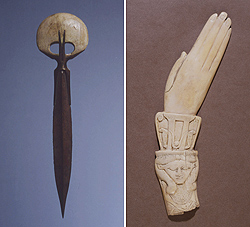Berkeleyan
 |
A leaf from the Hearst medical papyrus from the early 18th dynasty, during the joint reign of Hatshepsut and Thutmose III. (Photo courtesy the Bancroft Library) |
New de Young features Berkeley contributions, both inside and out
| 20 October 2005When the new M.H. de Young Museum in Golden Gate Park opened this past weekend with a celebrity-studded gala, the Newsoms, Wilseys, Pelosis, Gettys, and others who noshed and sparkled their way around the grounds and through the galleries found much to admire in the contributions of Berkeley academics, past and present.
The landscaping of the nearly five acres surrounding the public art museum is the handiwork of Walter Hood, an award-winning professor of landscape architecture and environmental planning. The new landscaping, said Hood, changes how the museum relates with the park surrounding it, creating a hybrid of a public park and a public museum.
The previous museum building on the site was demolished after suffering damage in the 1989 Loma Prieta earthquake. The revitalized project includes the 35,000-square-foot Barbro Osher Sculpture Garden and terrace and the 47,500-square-foot George Marcus Children's Garden (which includes a "fog bog"). It also retains the site's historic 100-year-old palm trees, the sphinx sculptures that graced the entrance to the original museum, and specimen cypress, pine, and redwood trees, Australian tree ferns, and eucalyptus trees in planters inside the museum.
 An ivory clapper and a bronze-and-ivory dagger, both from Egypt's 18th dynasty (1550-1295 B.C.), are on loan to the de Young from the Hearst Museum of Anthropology. (Photos courtesy the Hearst Museum of Anthropology) |
After that, Keller said, she was depicted in statues and other iconic representations as male, reflecting the values of the patriarchal society that associated power with gender.
That exhibit also includes a piece of ancient medical papyrus from the Bancroft Library's Center for the Tebtunis Papyri, as well as an ancient bronze-and-ivory dagger and an ivory-clapper musical instrument excavated from southern Egypt around the turn of the 20th century for what today is the Phoebe Apperson Hearst Museum of Anthropology.
Keller worked on the exhibit with former Berkeley Ph.D. students in Near Eastern Studies: Catharine Roehrig, curator in the department of Egyptian art at the Metropolitan Museum of Art in New York City, and Renee Dreyfus, curator of ancient art and interpretation with the Fine Arts Museums of San Francisco. The nearly 300 exhibit items include statuary, furnishings, jewelry, and other decorative arts. The exhibit, which has been years in the making, blends the latest scholarship on Hatshepsut with historical and social data about the era when she reigned. An audio tour, in which Keller is one of the guides, features a musical score.
Numerous museums contributed pieces to the exhibit, including the Egyptian Museum in Cairo, the Louvre, the British Museum, and the Hearst Museum, among others.
Admission to the de Young is $10 for adults, $7 for seniors, $6 for youth ages 13-17. Children 12 and under are free; in addition, the museum is free to all the first Tuesday of each month. There is a $5 surcharge for the Egyptian exhibit. Tickets for the show, which runs through Feb. 5, 2006, can be bought in advance through www.thinker.org.

